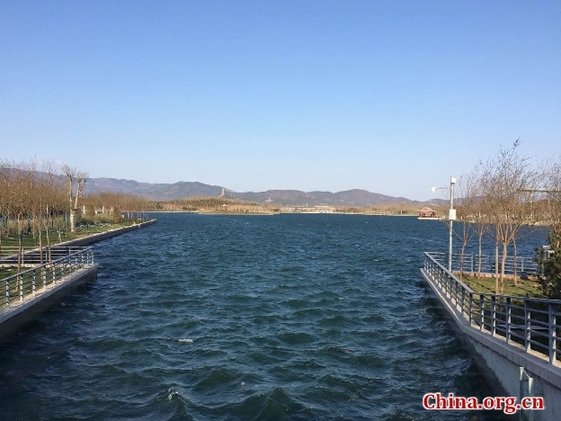 |
A section of the canal of the central route of China's South-to-North Water Diversion project in Beijing. [Photo by He Shan/China.org.cn] |
China's South-to-North Water Diversion project, the biggest water transfer scheme in the world, has supplied drinking water to 38 million people as the colossal project has delivered 2.17 billion cubic meters of fresh water to thirsty northern China since its central route was put into operation on Dec. 4, 2014.
The central route of the project was inaugurated in December 2014 after 11 years of construction. The route runs from Danjiangkou Reservoir on the Hanjiang River, a tributary of the Yangtze River, through Henan and Hebei provinces, to Tianjin and Beijing.
According to statistics released by the administration of the central route, Beijing, Tianjin, Hebei and Henan received 822 million, 373 million, 125 million and 847 million cubic meters of water from the central route over the past year.
While the fresh water has flowed to the taps of local residents, water quality is the top concern.
"Since the project was operational, monitoring results have met grade II measurements," said head of the project's water quality control center.
Mrs. Ren Ming, a resident living in Zhengzhou, the capital city of Henan Province, said, "Since the water came, the unpleasant smell has disappeared. Porridge made with the water now tastes good."
She also said her family used to drink bottled water but now they drink boiled tap water.
The central line has replenished the region's dwindling lakes and rivers by injecting a total of 27 million cubic meters water in Henan Province.
The project began sending emergency water supplies to Pingdingshan in Henan Province in mid-August when the city was hit by the worst drought in 63 years. The central route delivered more than 60 million cubic meters of water to the city's Baiguishan reservoir, relieving the scarce water supply of the city's one million-plus residents.
The project has met 70 percent of the supply of Beijing's urban water, covering its downtown areas and some of its suburbs.
The Beijing municipal water bureau announced in September the level of the city's groundwater has rebounded for the first time in 16 years.
Wang Junwen, head of the water resources control center of Beijing Water Authority, said, "Beijing has seen a slower decline of underground water level thanks to the south-to-north water diversion project."
The water project is a blessing for the city of Tianjin whose water supply used to mainly rely on underground water and the Luanhe River, a tributary in northern Hebei Province.
More than half of the residents in Tianjin have benefited from the water diversion project.